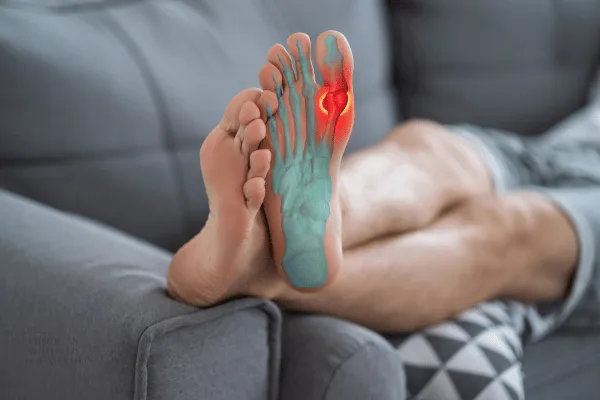About Arthritis
As the nation’s #1 cause of disability, arthritis affects nearly 60 million adults and 300,000 children. Over 100 types of arthritis and related conditions damage the joints and often other organs.
How can we assist you?
Helpful Tools for You

Millions of Americans Struggle with Gout: The Ongoing Challenge of Treatment Adherence
The condition is marked by episodes of intense joint inflammation or “flares” that can strike without warning. Each flare results from needle-like crystals of uric acid depositing in the joints, leading to severe pain, redness, and swelling. Over time, repeated crystal buildup can also cause long-term joint problems if the disease isn’t well contro
Gout flares often strike unexpectedly, causing extreme pain and swelling in the affected joint. For example, an acute gout attack in the big toe can be so painful that even the weight of a bedsheet becomes unbearable. These flare-ups can last for days at a time and disrupt one’s ability to walk, work, or even sleep normally. With pain levels this high, it’s no surprise that gout flares are incredibly disruptive to daily life – routine tasks and quality of life take a hit whenever a flare occurs.
Fortunately, gout is very treatable. Medications are available that target the root cause (excess uric acid) and can prevent flares from happening. The standard urate-lowering therapy is allopurinol, a daily oral medication that helps the body maintain safe uric acid levels. Clinical experience and studies have shown that medications like allopurinol are effective in lowering uric acid and preventing gout attacks over the long term. Rheumatologists often say that with the right treatment plan, gout flares can be reduced dramatically or even eliminated. In other words, people with gout don’t have to live at the mercy of flare-ups – consistent treatment can keep the disease in check.
Effective Treatments Exist, but Many Patients Fall Behind
Despite the proven effectiveness of these medications, a persistent challenge remains: many gout patients do not take their prescribed medications consistently. Adherence to allopurinol (and other urate-lowering drugs) is notoriously poor in the real world. In a recent national survey analysis, researchers found that only about one-third of gout patients achieved a high adherence to their allopurinol regimen, while the rest either took it inconsistently or never filled their prescription at all. To break down the numbers: roughly 27% of patients studied had never even filledadherence. This means that the majority of gout patients are not fully benefiting from medications that could spare them pain and long-term complications.
Why would someone not take a medicine that can prevent such agonizing flares? Gout presents a unique adherence challenge. One reason is that gout symptoms are episodic – patients might feel perfectly fine between flares. Unlike conditions with daily symptoms, gout can lull patients into a false sense of security when the pain subsides. Some individuals may start a urate-lowering drug after a bad attack, but then stop taking it once they feel better, not realizing that the medication needs to be continued to keep uric acid levels down. In other cases, initial side effects or the occurrence of a flare soon after starting treatment (a common phenomenon when beginning allopurinol) might discourage patients from continuing. The result is a large treatment gap: even though the tools to control gout are available, many people are not consistently using them, setting the stage for preventable flares.
The Adherence Gap: Who Faces the Biggest Challenges?
Not all patients struggle with gout treatment to the same degree. Research has highlighted significant disparities in medication adherence for gout. In particular, Black patients and individuals living in the U.S. South have the lowest rates of consistent treatment. One study found that Black gout patients were only about half as likely to maintain high adherence to allopurinol compared to White patients. Similarly, patients residing in Southern states had substantially lower adherence on average than those in the Northeas These findings held true even after accounting for factors like income, education, and insurance, suggesting that there are underlying social or healthcare system factors driving the gap.
This disparity is alarming because it points to unequal outcomes – the groups with lower adherence are likely experiencing more frequent flares and complications. The reasons behind these differences are still being explored, but they may include variations in healthcare access, cultural factors, and communication gaps. For example, the Southern U.S. has higher proportions of rural communities where access to specialists and pharmacies might be more limited. Black patients, on average, may face systemic barriers or historical mistrust in medical settings that affect how treatments are adopted. What’s clear is that targeted interventions are needed, as experts emphasize, to improve adherence in these vulnerable groups. Gout is a condition where everyone should be able to benefit from therapy, so closing these gaps is an important public health goal.
Consequences of Skipping Gout Treatment
Failing to stick with gout treatment has serious consequences. In the short term, inconsistent or absent therapy means more frequent flares, each bringing intense pain and disruption. But the impact doesn’t stop at temporary pain. Over the long term, uncontrolled gout can lead to permanent joint damage. Deposits of urate crystals (known as tophi) can accumulate in joints and even under the skin, gradually destroying cartilage and bone. Joints that have weathered years of untreated gout may develop a chronic arthritis with persistent pain and loss of mobility. In fact, doctors warn that gout which “goes untreated can lead to worsening pain and joint damage,” eventually causing visible joint deformities if not addressed. In essence, untreated gout can turn from an intermittent nuisance into a continuous, disabling arthritis.
Beyond the joints, gout can affect overall health in surprising ways. Chronic inflammation and high uric acid levels are linked to cardiovascular problems. Medical studies have observed that people with gout have higher rates of heart disease and stroke than those without gout. Part of this is because many gout patients have other risk factors (like high blood pressure or obesity), but gout flares themselves may also stress the cardiovascular system. One large study from Duke University found that among patients with heart conditions, those who also had gout had a 15% higher risk of dying from cardiovascular causes or suffering a heart attack or stroke compared to similar patients without gout. In fact, gout sufferers had roughly double the risk of death from heart failure in that analysis This doesn’t mean gout directly causes heart disease, but it signals that uncontrolled uric acid and flare-ups go hand-in-hand with worse health outcomes. The takeaway is clear: long-term lack of gout treatment can invite more than just joint pain – it can threaten your heart health as well.
Common Barriers to Staying on Treatment
If gout medication is so important, what keeps patients from taking it? There are several common barriers that contribute to poor treatment adherence:
Medication Cost: Even though allopurinol is an older generic drug (often relatively inexpensive), cost can still be a barrier for some patients. Those without good insurance coverage or with high co-pays might skip refills to save money. Studies of many chronic illnesses, not just gout, have shown that higher out-of-pocket costs lead to lower medication adherence. For some newer gout therapies or those with multiple medications, the financial burden adds up. Simply put, if patients can’t afford their medication or perceive it as too costly, they are less likely to take it consistently.
Access to Healthcare: Managing gout properly usually requires regular interaction with the healthcare system – doctor visits for monitoring uric acid levels, periodic lab tests, and easy access to prescription refills. In areas with limited healthcare access (for example, rural regions or underserved communities), patients might have difficulty maintaining this routine care. Limited access to rheumatologists or primary care providers can mean gout goes undertreated. If a patient has to travel long distances or wait months for an appointment, it’s much harder to stay on a preventative medication plan. Healthcare access gaps can thus translate into treatment gaps.
Knowledge and Education: A lack of understanding about gout and its treatment is a major factor in non-adherence. There are many misconceptions about gout – some think it can be managed by diet alone, or that you only need medication during an acute attack. In reality, urate-lowering therapy is a long-term commitment. Patients who aren’t educated about the chronic nature of gout may not realize the importance of taking their medication every day. As one expert noted, gout treatment is “plagued by multiple misconceptions,” and simply cutting back on rich food or alcohol is seldom enough to control the disease. Without clear guidance, a patient might stop their pills once the pain subsides, not understanding that the uric acid is silently building up again. Better patient education – explaining that gout is a lifelong condition and that these drugs prevent future flares and damage – is crucial to overcoming this barrier.
Other factors can include side effects fears, polypharmacy (when patients already take many other drugs), or even the stigma associated with gout (some patients feel embarrassed and may downplay their condition or skip follow-ups). Each patient may have a different combination of hurdles. The key is recognizing these barriers and addressing them head-on through support and education.
Supporting Better Treatment Adherence
If you or a loved one has gout, now is a great time to reflect on the current treatment plan. Ask yourself: Am I (or is my family member) taking the prescribed medication every day as directed? If the answer is no or “only sometimes,” consider what obstacles are in the way. Is it the cost of the drugs, difficulty getting to the pharmacy or doctor, or uncertainty about why the medication is needed? These challenges are common, but they can be overcome with the right support. Start by having an open conversation with your healthcare provider about any problems or concerns. Doctors can often adjust the regimen or provide resources – for example, switching to a cheaper generic, managing side effects, or connecting you with financial assistance programs – to help you stay on track.
It’s also important to build a support system around your gout care. This could mean enlisting a family member to help remember your daily pill, joining a community or online support group of others managing gout, or using reminder tools (like smartphone apps or pill organizers) to keep you consistent. Education is power: take advantage of reputable sources (like the Arthritis Foundation) to learn more about gout and why long-term treatment is so beneficial. When you understand that staying on medication today can prevent pain and protect your joints and heart down the road, it becomes a lot easier to stick with it.
Gout may be a chronic, lifelong condition, but it doesn’t have to control your life. By recognizing the barriers that have kept many people from taking their medications and actively working to remove those barriers in your own life, you can take charge of gout. The next time you speak with a friend or relative who has gout, encourage them to do the same – ask if they have the support they need, and share what you’ve learned. With better adherence to treatment, those painful flares can become far less frequent, and the long-term complications can be avoided. It’s a collective effort between patients, healthcare providers, and communities to ensure that proven gout treatments deliver on their promise – freeing people from needless pain and helping them live their lives to the fullest, flare-free.

Effects of Arthritis

Cause of Disability
In the United States, 23% of all adults, or more than 54 million people, have arthritis. It is a leading cause of work disability, with annual costs for medical care and lost earnings of $303.5 billion.

Workforce Effects
Sixty percent of US adults with arthritis are of working age (18 to 64 years). Arthritis can limit the type of work they are able to do or keep them from working at all.

Global Impact
In fact, 8 million working-age adults report that their ability to work is limited because of their arthritis. For example, they may have a hard time climbing stairs or walking from a parking deck to their workplace.
Promoting Interventions That Reduce Arthritis Pain
American Arthritis Foundation recognizes several proven approaches to reduce arthritis symptoms:
Be active. Physical activity—such as walking, bicycling, and swimming—decreases arthritis pain and improves function, mood, and quality of life. Adults with arthritis should move more and sit less throughout the day. Getting at least 150 minutes of moderate-intensity physical activity each week is recommended.
Protect your joints. People can help prevent osteoarthritis by avoiding activities that are more likely to cause joint injuries.
Talk with a doctor. Recommendations from health care providers can motivate people to be physically active and join a self-management education program. Should your arthritis be interfering with your activities of daily living you may be a candidate to receive many new treatments, and learn how to reverse the arthritis condition.
Have a question?
We're Here to Help
By providing my phone number, I agree to receive text messages from the business.


